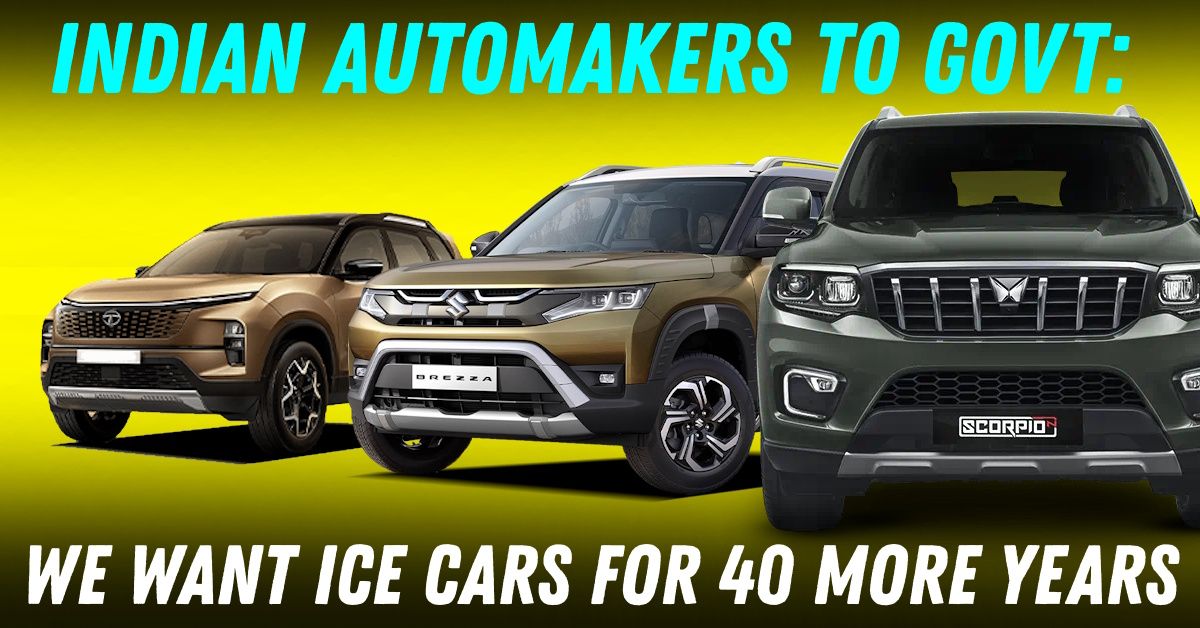Auto Industry To Indian Govt: Want To Have ICE Vehicles On Roads For 40 More Years


In quiet boardrooms across Delhi and Mumbai, a big debate is heating up. Car companies are trying to convince the government to let petrol and diesel vehicles stay on Indian roads until 2055. That’s 15 years longer than the earlier plan to stop selling these cars by 2040. The push, led by the auto industry, is based on a mix of practical, environmental, and economic reasons.
The Society of Indian Automobile Manufacturers (SIAM) is leading the argument against an early end to internal combustion engine (ICE) vehicles. They believe it’s not just about needing more time. The bigger question, they say, is whether electric vehicles (EVs) can really be the perfect solution for India right now.
Power shortages remain a major concern. In 2012, more than 650 million people were hit by huge blackouts. Even today, many states face power cuts ranging from 2 to 8 hours daily. A recent survey shows that over half of Indian households deal with at least 2 hours of power cut every day. For most families, home charging an EV is not realistic when electricity itself is unreliable.
There’s a twist in the clean mobility story. According to HSBC Global, hybrids are currently cleaner than EVs in India. Hybrids produce about 133 grams of CO₂ per kilometre, compared to 158 grams for EVs. Even in 2030, when 40% of power is expected to come from non-fossil sources, hybrids will still emit less.
The main reason is India’s coal-heavy electricity grid. With over 80% of power still coming from fossil fuels, charging an EV may not be as green as it sounds. Until renewable energy makes up at least 44% of the grid, hybrids will continue to have an edge.
The auto industry is also betting big on cleaner fuels. Ethanol blending is already happening, with a target of 20% ethanol in petrol by 2025. But the real game changer is second-generation biofuels made from farm waste. India produces 300 million tonnes of this waste every year.
In Uttarakhand, a plant in Kashipur is turning this waste into bioethanol. This reduces stubble burning, creates jobs, and cuts fuel imports. The country can already make 684 crore litres of ethanol a year, and this could more than double soon.
Bio-CNG is also in the mix. Made from sugarcane waste, it’s being produced in 44 plants across 13 states. With a daily capacity of 2.18 lakh kg, this fuel can run in current engines with no changes needed.
Even Formula 1 is moving towards cleaner fuels. By 2026, the sport aims to run entirely on synthetic fuels. These are made using carbon dioxide pulled from the air and hydrogen split from water using renewable electricity.
The idea is simple: clean electricity powers machines that make fuel which can go into any regular engine. Though it costs four times more than petrol today, it doesn’t need new infrastructure. No charging stations, no battery worries, just cleaner fuel in the same pumps.
Another challenge is where to charge EVs. Almost 90% of Indians don’t have fixed parking. In cities, cars are parked anywhere there’s space. Creating dedicated charging points is tough when people don’t even have regular parking spots.
Even in fancy buildings, people face resistance from housing societies when they try to install chargers. Issues like cost, safety, and permissions make EV ownership tough unless you already have a private, permanent parking space.
A major concern is our dependence on China for EV components. China makes 75% of the world’s EV batteries and over half of all EVs. It also dominates in refining the minerals needed - processing most of the world’s nickel, cobalt, and lithium.
In the last five years, India has imported over $7 billion worth of EV batteries and parts from China. With ongoing border tensions and global trade uncertainties, this dependency could become a serious risk.
States like Rajasthan and Haryana are seeing the worst power shortages in six years. In one month alone, electricity demand exceeded supply by 1.88 billion units. During such times, some EV owners have turned to diesel generators to charge their cars, defeating the entire purpose of going electric.
While solar and wind energy are getting cheaper, India’s current renewable energy share is only 26%. We need to reach 44% to make EVs truly cleaner than hybrids. But scaling up solar and wind energy quickly is expensive and slow, requiring nearly ₹1.7 lakh crore every year.
Some believe nuclear power could help, but it comes with its own problems. Though current plants are considered safe, the real issue is handling radioactive waste. Nuclear capacity in India is growing slowly and may not be enough to change the power mix anytime soon.
Extending the life of ICE vehicles is not just about saving money for carmakers. It’s about keeping mobility affordable and practical for most Indians. Using a mix of hybrids, biofuels, and synthetic fuels can offer a cleaner and more realistic path while EV infrastructure slowly improves.
The government now faces a choice. Should it stick with the 2040 ban on ICE vehicles, which may leave millions without mobility options? Or should it support a slower, more flexible shift where cleaner fuels and improved engines keep cars running while we build the EV ecosystem?
In the end, the future may not be 100% electric. A balanced approach, where both EVs and cleaner ICE vehicles coexist, could be the smartest and fairest way forward for India.
Via BusinessStandard